

Last updated on

The following excerpt is taken from “SEO in the Gemini Era” by Marie Haynes ©2024, published with the permission of Marie Haynes Consulting Inc.
A lot of today’s SEO advice originates from shared community insights gathered in the pre-Google AI era of search.
The practices many of us in SEO consider standard today are rooted in the era when search engines operated primarily on heuristics—a set of handwritten rules programmed by humans. However, the landscape has evolved significantly since then.
For instance, imagine you’re tasked with writing a new article for your website.
You’d likely begin with keyword research because we understand that to appear relevant to search engines, your content must comprehensively cover a topic and incorporate semantically related keywords.
Much of the content you find online today is the result of a process that resembles this:
None of these steps lead us to create content that is truly original, insightful, and significantly more valuable than what already exists online.
However, that’s exactly what Google aims to reward!
An SEO agency often dedicates many hours each month to enhancing a site’s technical SEO, refining internal linking structures, and acquiring external links and mentions. While these efforts can potentially enhance a webpage’s appeal to search engines, they typically don’t fundamentally enhance the content’s usefulness to searchers, which is precisely what Google prioritizes rewarding.
Let me be clear: I’m not suggesting that technical SEO is irrelevant.
Having a technically sound, fast-loading site that search engines can easily crawl and understand can yield benefits, particularly for larger sites.
Schema markup can still greatly assist Google in understanding your business and its E-A-T (Expertise, Authoritativeness, Trustworthiness), particularly for newer entities. In some industries, technical enhancements can provide enough advantage to improve rankings to some extent.
But there’s one crucial factor that truly enhances content’s value.
Are you prepared for this profound, enlightening secret?
Here it is…
The key to creating content that Google is likely to recognize as more valuable than others’ is to ensure it genuinely helps users.
For over a decade, my primary income has stemmed from advising businesses on enhancing their visibility in search results.
I’ve meticulously studied every statement Google has made about what they prioritize for rewarding, resulting in countless pages of checklists, training materials, and advice.
My singular aim was to help people grasp what Google values and guide them towards achieving those outcomes.
Do you notice the irony in that statement? The more I reflect on it, it’s almost comical!
Throughout this time, while advocating for creating user-focused content—now termed “People-first content” by Google—much of my efforts inadvertently leaned more towards appeasing Google rather than genuinely satisfying users.
Many other SEO professionals are now awakening to this realization. The actions users take on our websites hold immense importance. These actions significantly influence Google’s ranking decisions.
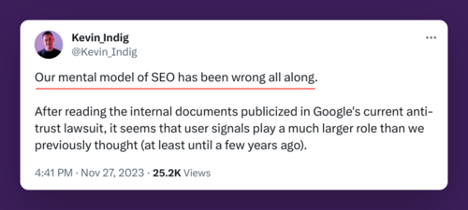
Traditionally, I’ve approached Google’s recommendations on crafting helpful content as a checklist for improvement:
Have an author bio? Check. Clear, descriptive headings? Check. Demonstrate expertise and provide informative content? Another check.
My initial book on crafting valuable content guides you through various checklists like these. Following these checklists can lead to noticeable improvements.
In fact, I frequently hear from people who have implemented changes based on these checklists and have seen positive results.
However, it turns out that what Google provided us with wasn’t simply a set of criteria to tick off like items on a checklist!
I now understand that Google’s guidance was more nuanced: Their systems are designed to reward content that users find genuinely helpful and trustworthy. Google offers suggestions to help us understand what users generally appreciate.
It’s not about adhering to a checklist, but rather recognizing the types of content and features that resonate with searchers. The algorithm is structured to favor what users prefer.
For instance, while an author bio itself may not directly impact rankings, in many industries, showcasing the expertise of your authors is valued by users.
Similarly, core web vitals—metrics like page load times—were once just scores we aimed to achieve. However, we now focus on improving these metrics because users prefer pages that load quickly and provide a smooth browsing experience.
Google doesn’t use a checklist or scorecard to assess the quality of every page. Google lacks precise knowledge of your content and whether it meets high-quality standards.
As we discussed earlier, search operates on a sophisticated AI system that aims to predict what will be valuable to searchers.
Google offers a set of “ideas” to help us gauge what searchers may find useful:
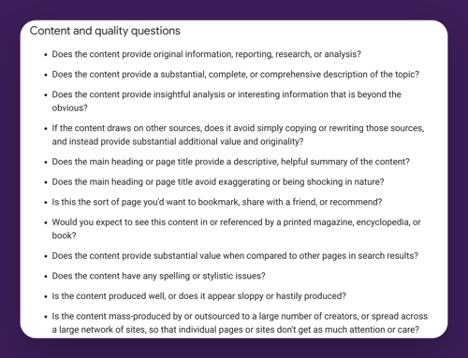
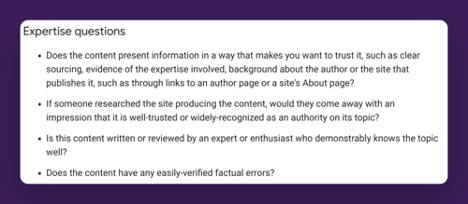
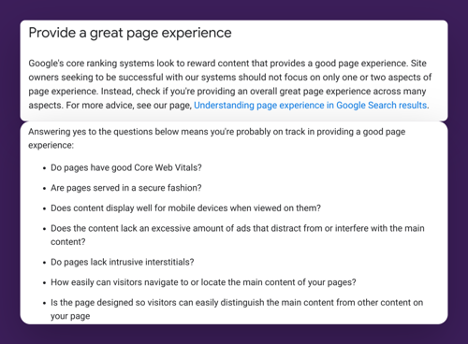
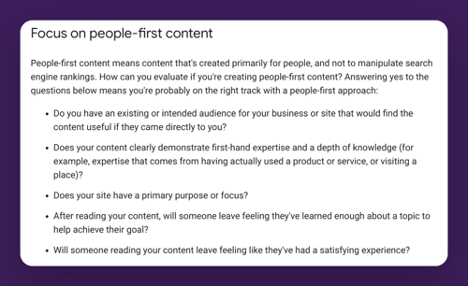
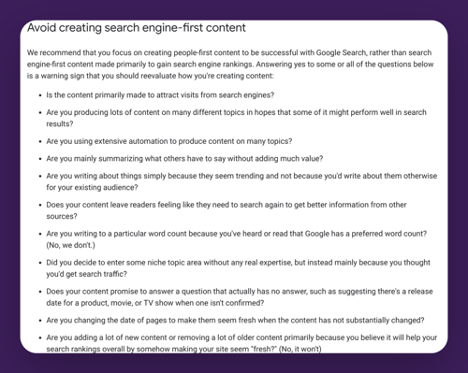
In the past, I’ve taught how to examine these principles individually for insights on improving your website, and I still see great merit in this approach.
However, I’ve come to realize I’ve been focusing on helpful content from an SEO perspective.
The correct approach is quite the opposite.
Creating truly People-First content means you’re inherently aligned with Google’s guidelines for valuable content.
I had it backwards.
Understanding your audience’s needs, addressing their questions, and crafting content that meets those needs are the foundations of creating the type of People-First Content that Google aims to promote.
Typically authored by individuals with practical expertise in a given field, content gains credibility when derived from firsthand experience. For instance, a retail store selling a product often offers valuable insights based on interactions with real customers. Similarly, professionals who regularly advise on a subject tend to provide up-to-date information that addresses current audience needs.
However, there are exceptions to this rule. At times, authority outweighs direct experience, as illustrated by Forbes ranking high in searches for topics like BBQ reviews. Forbes’ standing as a trusted journalistic entity lends it sufficient E-A-T (Expertise, Authoritativeness, Trustworthiness) to be regarded as a reliable source on such topics. As long as users signal satisfaction with the content, it will likely maintain its high rank—although this might evolve as we strive to produce more genuinely helpful content recommended by subject matter experts.
Effective content, as recognized by Google, is characterized by its ability to deliver real value to searchers. It should be clear, concise, and easily understandable, offering original and insightful perspectives. The challenge lies in understanding how Google evaluates these qualities.
In the following section, we delve into a relatively recent revelation for SEO professionals: the significance of user engagement signals in Google’s ranking algorithms. These signals, derived from interactions within search results, are systematically analyzed through machine learning systems. The goal is to optimize the delivery of information that best satisfies the searcher’s intent, reflecting Google’s ongoing efforts to enhance search relevance and user experience.
Original news from SearchEngineJournal